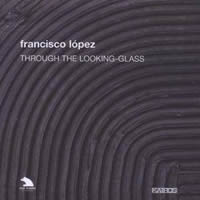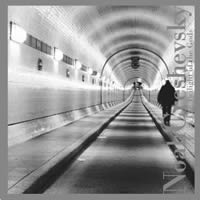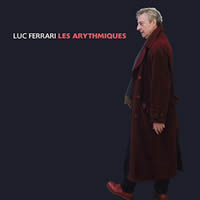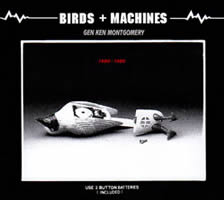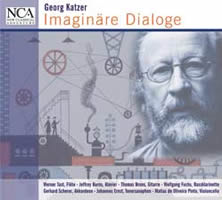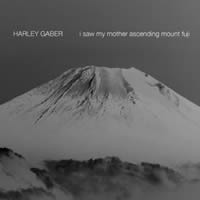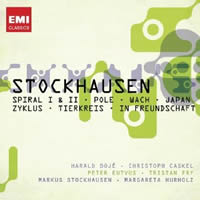EA Bucket 12.
|
Grant Chu Covell [August 2010.]
“Through the looking-glass.” Francisco LÓPEZ: La Selva (1997); Belle Confusion 969 (1996); Buildings [New York] (2001); Qal’at Abd’al-Salam (1993); O Parladoiro Desamortuxado (1995); untitled (2008). Kairos 0112872KAI (5 CDs) (http://www.kairos-music.com/). As a sometime electroacoustic practitioner, I listened to this set as other than as critic. While all composers are critics, the obverse is not necessarily true — a discussion for another day. Having done a 180 on López before, I tried for an open mind without expecting to feel so removed from these five discs. Notwithstanding the often pretentious commentary (“Reality and virtuality in phenomenological sound matter”), this bundle reveals López more as a hunter-gatherer operating under the Cagean aesthetic wherein drawing the picture frame constitutes the work of art. Does allowing a tape to roll in a rainforest, to be played in an air-conditioned studio on a different continent, achieve some kind of compositional standard? Belle Confusion 969’s solitary 51:32 track, assembled from seven years of visits to tropical and sub-tropical forests in South America, Africa and China, was “composed and recorded” in Spain. How much editing or manipulation need occur before such as this achieves status as music? Do such questions even matter? López’s activities span the gamut from near-zero to deterministic tampering. You must first ask yourself whether you enjoy the rainforest or mechanical noises before you strip away the shrink wrap. For my part, the box sparked memories of the times I sat in the middle of a field, wandered around a deserted convention center, and circled a manufacturing plant. One perhaps needs to be a fellow collector for maximum enjoyment — López seems to be somewhat obsessive in this regard. My memories were taking me to similar places, and yet of my own, and I enjoyed myself for reasons again of my own. The best discs — the ones that set my mind to wandering — are those which may have spent less time in the studio (La Selva’s 70:49 single span represents Costa Rican recordings captured 1995-96; the 69:04 of Buildings [New York] assembles Manhattan and Brooklyn sources) as compared with those that underwent “a complete unrecognizability of the original source matter” (untitled’s three parts). Perhaps the note’s provocative philosophical landmines lay down a smokescreen for what are essentially expanses of ambiance. Would I have been more entranced had I not recalled my own attempts at catching the swish of wind through weeds or the thump of a noisy boiler? Buildings [New York] takes on a bittersweet dimension with its 2001 World Trade Center recordings. Of course there are many recordings of places that no longer exist, and many more made by performers who are no longer with us. Let us not forget that we make recordings in order to capture the ephemeral. Somewhere in the house, perhaps degraded by now, are tapes I made in the Hagia Sophia. My delay to transfer them to computer or CD is part laziness and part reluctance. I believe that my memory of standing still in one of the most amazing structures on this planet cannot live up to whatever I captured on tape. Is López a fine composer because his work sparked these emotions? Probably not. However, I appreciate how he deactivated the critic within for at least a few hours.
“The Twilight of the Gods.” Noah CRESHEVSKY: Götterdämmerung (2009)1; Omaggio (2001); Three Minute Waltzes (2009); Brother Tom (2008)2; Estancia (1999); I Wonder Who’s Kissing Her Now (2008); La Belle Dame Sans Merci (2009)3; Happy Ending (2009)4. Credited samples from The Klez Dispensers1, Thomas Buckner2, Ellen Band3, Ray Marchica4, Sons of Sound4. Tzadik TZ 8069 (http://www.tzadik.com/). The caffeinated or otherwise agitated are advised to avoid Creshevsky’s “hyperrealist music.” His tightly spliced, fast-paced samples are just barely playable. In the opening piece a frenetic composite of scat singing shifts abruptly to Klezmer. Was the first half generated from the same material? The closing entry similarly bounces along with an electric guitar and drum set. Because Creshevsky’s sources are pinch-sized, it’s hard to discern the originals. Estancia probably chops up flamenco guitar. Omaggio and I Wonder Who’s Kissing Her Now command orchestras — I think I heard bits of Schoenberg in both. Ultimately, who can tell? La Belle Dame Sans Merci with its slower pace over synthesized plucks and vibes bucks the trend. The titles puzzle with references only partially fulfilled.
Luc FERRARI: Les Arythmiques (2003). Blue Chopsticks BC 19 (http://www.dragcity.com/products?filter_label=BC). Ferrari fanatics covet INA GRM’s 10-CD collection, Luc Ferrari: L’oeuvre électronique (INA GRM 6017/26) even though they may already possess most of the brick’s content. Blue Chopsticks plucked out one item which hadn’t been released previously, the 2003 Les Arythmiques. Its seven tracks, barely extending to 41 minutes, sum to a weighty composition that sticks in the mind. Les Arythmiques concerns memories and death. Akin to Schoenberg’s autobiographical String Trio, which chronicles the composer’s heart attack, Ferrari recreated the electric shock that restored his cardiac rhythm: “They made me an electrocardiogram and they showed it to me. I found that the arrhythmias were not very interesting, that I could do better.” Typical Ferrari pluck! As to the shock’s portrayal, I don’t hear electricity so much as gravel dumped in a chute. Here is perhaps Ferrari’s most oppressive electroacoustic work, with dark fundamentals and an unfocused narrative. Throughout the piece recurring sounds snap to attention for no apparent reason. Even for Ferrari, the logic is missing. Ferrari’s humor is evident in the juxtapositions and excerpted speech with its fitting final line.
“Birds + Machines.” Gen Ken MONTGOMERY: Var comps (1980-89, 2009). Pogus P21055-2 (http://www.pogus.com/). Having met Montgomery before, I’m inclined to call this a retrospective. A few animals blend with electronics as advertised. Two introductions swiped from live performances interrupt 13 tracks. The slipcase’s indications of venue and year promote a sprint down memory lane. The generally modest durations imply excerpts from performances or improvisations, even though seemingly unrelated tracks segue rather easily — an amateur’s lassitude. There’s quite a bit of what sounds like looped electronic violin and filtered rhythms (Subliminal Clutter, Part 2). The oldest tracks (Shoot Me Down, Treat the Hell out of It, Falling Down Stairs) loiter with electric guitar, distorted voice and filtered noise, a type of ’80s music largely ignored on these pages. We should be thankful Montgomery wandered elsewhere.
“Imaginäre Dialoge.” Georg KATZER: Dialog imaginär Nr. 1, “La flute fait le jeu” (1979)1; Dialog imaginär Nr. 2, “ad parnassum” (1986)2; Dialog imaginär Nr. 3, “Stillleben mit Gitarre und Hegel” (1991)3; Dialog imaginär Nr. 4, “Atmung” (1990)4; Dialog imaginär Nr. 5, “Versuch über die wahre Art das Akkordeon zu spielen auf dem Marktplatz von Bourges” (1993)5; Dialog imaginär Nr. 6, “stockendes Lied” (1995)6; Dialog imaginär Nr. 7, “falsche Spiegel” (2004)7. Werner Tast1 (fl), Jeffrey Burns2 (pno), Thomas Bruns3 (guit), Wolfgang Fuchs4 (bclar), Gerhard Scherer5 (accordion), Johannes Ernst6 (t-sax), Matias de Oliveira Pinto7 (vlc). NCA 60153-314 (2 CDs) (http://www.ncamusic.com/). Georg Katzer got into music in high school: “I started composing and was shocked to hear things I thought I had created myself being played on radio.” A leading proponent of electronic music in the newly minted East German state, Katzer sees his Imaginary Dialogue series as similar in sweep to Debussy’s Préludes or Berio’s Sequenzas. Numbering seven, each dialog pairs an instrumentalist with tape. In most cases the tape sticks to processing its instrument’s sound, and this is where Katzer’s invention shines. The flute-plus-tape closet, concealing ghouls galore, inspires Katzer to exploit the instrument’s partial structure and devise interesting percussive effects. This composer rarely overpacks. The taped piano may undergo extreme filtering to emerge as quite a different shadow from its live counterpart. Stillleben mit Gitarre und Hegel requires the guitarist to recite — I immediately thought of Lachenmann’s 1977 two-guitar Salut für Caudwell. The accordion dialogue spoofs a C.P.E. Bach title (several tape parts were realized in the Bourges GMEB studios), its street noises suggest that the performer is busking. Falsche Spiegel with cello impressed me as less inventive.
Harley GABER: I Saw My Mother Ascending Mount Fuji (1968-2009). Innova 231 (http://www.innova.mu/). While Gaber’s captivating title proves unachievable, his notes about the work’s gestation offer an absorbing view of the paths a composition may take. A request for one piece led to a complete overhaul of two older works and occasioned some significant self-discovery along the way. The result is dedicated to two departed family members. At nearly 66 minutes, the unaffected weaving of pre-recorded violin and alto flute proved too daunting for this listener.
Karlheinz STOCKHAUSEN: Zyklus (1959)1; Spiral I (1968)2; Pole (1969-70)3; Spiral II (1968)4; Japan (1968-70)5; Wach (1968-70)6; Tierkreis (1974-75)7; In Freundschaft (1977, rev. 1997)8. Tristan Fry1 (percussion), Harald Bojé2, 3, 5, 6 (electronium, etc.), Peter Eötvös3, 4, 5, 6 (electrochord, etc.), Christoph Caskel5, 6 (perc), Markus Stockhausen7, 8 (trp), Margareta Hurholz7 (org). EMI 50999 6 95598 2 2 (2 CDs) (http://www.emiclassics.com/). These two discs contain a time machine to what was state-of-the-art in December 1971 when Pole, Japan, Wach and Spiral were recorded. Bojé, Eötvös and Caskel worked closely with Stockhausen across the ’60s and ’70s and performed Stockhausen’s music at Expo ’70 in Osaka. There are two performances of the solo Spiral: Bojé uses an electronium and short-wave radio, and Eötvös takes up zither, bamboo flute, reed pipe, synthesizer and short-wave radio. Both join for the duet Pole, Bojé bringing his equipment from Spiral and Eötvös using electrochord and radio. Japan and Wach, both from the Für kommende Zeiten collection, are realized by Bojé, Eötvös and percussionist Caskel. In Japan, Bojé and Eötvös give up their short-wave sets for woodblocks but retain their electronics. In Wach Bojé and Eötvös use only electronics. Structure and intent aside, these pieces with their squelches, bleeps and infrequent radio intrusions document intense free-form wandering. The noises charm, and it reassures to know there’s some guiding force. The set’s other items do not make as strong an impression. Fry’s Zyklus was recorded in two sessions in ’74 and ’75. This version of Tierkreis was taped in ’92, In Freundschaft in ’97. Neither the dozen zodiac pieces nor the solo, with the composer’s son Markus on trumpet, resonated with me.
[More EA Bucket, Grant Chu Covell]
[Previous Article:
Splatter 1: New & Improved!]
[Next Article:
Mostly Symphonies 14.]
|
